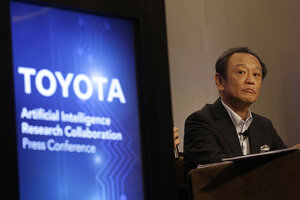Toyota invests $50 million to develop smarter human-driven car
The company says its future cars will serve as 'guardian angels,' nudging drivers when safety is threatened.

Kiyotaka Ise, Senior Managing Officer for Toyota Motor Corporation, listens to questions at a news conference in East Palo Alto, Calif., Friday, Sept. 4, 2015.
Jeff Chiu/AP
Toyota Motor Corporation announced Friday in California that it will invest $50 million to develop ‘intelligent’ cars and robotics in partnerships with the Massachusetts Institute of Technology and Stanford University.
Unlike driverless cars, which Google and Tesla have promised to deliver within the next several years, Toyota’s vision is to turn cars into ‘guardian angels’ that will alert drivers to imminent dangers and help drivers protect themselves from accidents. Toyota has said that it is not interested in developing fully autonomous cars, or vehicles that operate without human intervention.
“In parallel autonomy, there is a guardian angel or driver’s education teacher,” Gil Pratt, a robotics expert who left the military's Defense Advanced Research Projects Agency to lead the research effort, told The New York Times. “It usually does nothing, unless you are about to do something dumb.”
Daniela Rus, director of MIT’s Computer Science and Artificial Intelligence Laboratory (CSAIL) explained in a press release that the objective of the research is not only to prevent collisions. The new technology will also serve as the eyes for a tired driver, warning of imminent danger, “and even offer helpful tips such as letting the driver know she is out of milk at home and planning a new route home that allows the driver to swing by the grocery store,” explains the release.
“Developing a vehicle that’s incapable of having an accident is an ambitious goal, but at CSAIL we’ve always focused on the moonshots,” Ms. Rus said.
Smart cars that have some ability to drive themselves are already on the roads, and more features are coming soon. For instance, the 2013 Mercedes-Benz GL can park itself, and the 2016 Chevrolet Malibu has collision warning and automatic braking. The new Volvo XC90 can take over the steering and speed control to follow the car in front of it at speeds of up to 35 mph.
“We’re taking out the part of people’s commute that they don’t like,” Volvo spokesman Jim Nichols told The New York times recently. “Even people who normally like to drive have told us they want the autonomous part for the more boring parts of their commute. So we’re giving it to them.”

